Research on Passenger’s Travel Mode Choice Behavior Waiting at Bus Station Based on SEM-Logit Integration Model
Abstract
:1. Introduction
2. Travel Mode Choice Behavior of Passenger Waiting at Bus station
2.1. Mechanism Analysis of Decision-Making Procedure
2.2. Influence Factor and Preference Analysis
- Explicit variables include passengers’ demographic and socioeconomic characteristics (i.e., gender, age, monthly income, education level, and vehicle ownership) and trip related characteristics (i.e., trip purpose, travel time, commute distance, frequency of taking a bus, and acceptable waiting time);
- Latent variables are mainly passengers’ satisfaction degree for public transport services level, and corresponding observational indexes are used to measure these latent variables [31], including safety (i.e., safety facilities, and personal and property safety), comfort (i.e., neat and tidy degree of the carriage, congestion degree of the carriage, seat comfort, and environment comfort), convenience (i.e., distance between home and bus station, distance between destination and bus station, and departure frequency), flexibility (i.e., waiting time, delay time, and bus operation speed) and economy (i.e., bus travel cost and cost rate in monthly income).
3. Methodology
3.1. Framework of SEM-Nested Logit Integration Model (SEM-NL)
3.2. Solution Method of SEM-NL Model
4. Case Study
4.1. Case Introduction and Description
- Passengers’ basic information on demographic and socioeconomic characteristics includes gender, age, monthly income, education level, and vehicle ownership [41];
- Travel characteristics include trip purpose, travel time, commute distance (the number of bus station), and frequency of taking the bus (daily, once 2–3 days, weekly, monthly and rarely) [42];
- Intention investigation includes passengers’ acceptable waiting time and travel choice in the case of bus delay [43];
- Evaluation of passenger satisfaction, the survey data covered five indicator variables reflecting the safety, comfort, convenience, flexibility and economy of bus operation characteristics and services using five-point Likert scale [44].
4.2. Data Analysis
5. Results and Discussion
5.1. Reliability Analysis of Latent Variables
5.2. Estimation Results of Passenger’s Satisfaction Degree Based on SEM Model
- The load factor of the latent variable “safety” to the observed variable “safety facilities” is 0.746, and the C.R. value is 10.948. The corresponding p value is less than 0.001, thus it can be considered that the factor has a significant difference with 0 at 99% confidence level.
- The load factor of the latent variable “economy” to the observation variable “overall satisfaction degree” is 0.152, and the C.R. value is 2.498. The corresponding p value is 0.013, thus it can be found that the probability of which the factor equals 0 is 1.3% at 95% confidence level.
5.3. Estimation Results of SEM-Logit Integration Model
5.4. Sensitivity Analysis of Variables
- Establish an effective and timely network prevention system. It is necessary to strengthen the construction of information sharing platform between public security organization and public transport enterprises, which can timely predict and accurately handle all types of emergencies.
- Provide more safety facilities (e.g., safety hammers, fire extinguishers, and emergency escape devices) and meet the travel needs of disadvantage group. The path analysis of the SEM model shows that the fitness value for Y1 on η1 is 0.305 in Equation (9), which reveals that passengers’ travel mode choice behavior can be influenced by safety facilities service level of the public transport.
- Integrate bus ticket system. Additional charges for transfer also affects the attractiveness of public transport. Passengers’ bus travel costs can be reduced through the integration of fares in transition operation design, which is also conducive to multi-level bus routes optimization.
- Create a comfortable bus travel environment, including waiting environment at bus station (i.e., comfort sheltering design, abundant passenger information system and necessary waiting hardware facilities), carriage environment (i.e., comfort seats, handrails and overloading is strictly forbidden) and road operating environment (e.g., increase the bus exclusive -roads and improve bus operation speed). The mode share of public transport can be effectively increased by improving its comfort service level.
6. Conclusions
Author Contributions
Acknowledgments
Conflicts of Interest
References
- Bhouri, N.; Mayorano, F.J.; Lotito, P.A.; Salem, H.H.; Lebacque, J.P. Public Transport Priority for Multimodal Urban Traffic Control. Cybern. Inf. Technol. 2015, 15, 17–36. [Google Scholar] [CrossRef] [Green Version]
- Wu, J.; Yang, M. Assessment of Passenger Satisfaction with Urban Bus Service Quality Using Bayesian Networks. J. Southeast Univ. 2017, 47, 1042–1047. [Google Scholar]
- Wang, Y.; Yan, X.; Zhou, Y.; Xue, Q. Influencing Mechanism of Potential Factors on Passengers’ Long-Distance Travel Mode Choices Based on Structural Equation Modeling. Sustainability 2017, 9, 1943. [Google Scholar] [CrossRef]
- Gruyter, C.D.; Currie, G.; Rose, G. Sustainability Measures of Urban Public Transport in Cities: A World Review and Focus on the Asia/Middle East Region. Sustainability 2016, 9, 43. [Google Scholar] [CrossRef]
- Takada, K.; Kobayashi, M. Analysis on Choice behavior of railway passengers when railway service stops. Infrastruct. Plan. Rev. 2010, 25, 763–768. [Google Scholar] [CrossRef]
- Zhang, Y. Influence of PIS on Passengers Waiting Behavior in Urban Rail Platform. Master’s Thesis, Beijing Jiaotong University, Beijing, China, 2014. [Google Scholar]
- Wu, H. Research of Multi-Modal Transit Scheduling Model Based on Passengers’ Waiting Behavior. Master’s Thesis, Harbin Institute of Technology, Harbin, China, 2016. [Google Scholar]
- Abane, A. Mode Choice for the Journey to Work among Formal Sector Employees in Accra, Ghana. J. Transp. Geogr. 1993, 1, 219–229. [Google Scholar] [CrossRef]
- Maria, V.C.; Umberto, G.; Antonio, M.; Michele, T. A European Vision for More Environmentally Friendly Buses. Transp. Res. Part D 2016, 45, 48–63. [Google Scholar]
- Maria, V.C.; Umberto, G.; Antonio, M.; Michele, T. A New Generation of Buses to Support More Sustainable Urban Transport Policies: A Path towards “Greener” Awareness among Bus Stakeholders in Europe. Res. Transp. Econ. 2016, 55, 20–29. [Google Scholar]
- Yao, L.; Sun, L.; Guan, H. Study on Modal Split Method Based on Nested Logit Model. J. Wuhan Univ. Technol. 2010, 34, 738–741. [Google Scholar]
- Zulqarnain, H.K.; Mark, J.M.; John, S.M.; Michael, D.F. Using New Mode Choice Model Nesting Structures to Address Emerging Policy Questions: A Case Study of the Pittsburgh Central Business District. Sustainability 2017, 9, 2120. [Google Scholar] [Green Version]
- Ben-Akiva, M.; Mcfadden, D.; Train, K.; Walker, J.; Bhat, C.; Bierlaire, M. Hybrid Choice Model: Progress and Challenge. Mark. Lett. 2002, 13, 163–175. [Google Scholar] [CrossRef]
- Johansson, M.V.; Heldt, T.; Johansson, P. The Effects of Attitudes and Personality Traits on Mode Choice. Transp. Res. Part A 2006, 40, 507–525. [Google Scholar] [CrossRef]
- Ji, Y.; Zhou, Y.; Gao, L.; Hu, B. Evaluation of Passenger Satisfaction Based on Structural Equation Modeling Approach. J. Transp. Eng. Inf. 2016, 14, 7–12. [Google Scholar]
- Habib, K.M.N.; Zaman, H. Effects of Latent and Attitudinal Information in Mode Choice Models. Transp. Plan. Technol. 2012, 35, 561–576. [Google Scholar] [CrossRef]
- Ekstrom, E.; Lotstedt, P.; Tysk, J. Boundary Values and Finite Difference Methods for the Single Factor Term Structure Equation. Appl. Math. Financ. 2009, 16, 253–259. [Google Scholar] [CrossRef]
- Yan, H.; Wang, X.; Liang, W.; Kong, L. Commute Traffic Mode Choice Based on Structural Equation Model. J. Beijing Univ. Technol. 2015, 41, 590–596. [Google Scholar]
- Gan, Z. Travel Mode Choice Behavior Analysis for Migrant Workers. Master’s Thesis, Chang’an University, Xi’an, China, 2015. [Google Scholar]
- Cheng, J. Research on Theory and Application of Travel Behavior and Urban Public Transit Pricing. Ph.D. Thesis, Southwest Jiaotong University, Chengdu, China, 2012. [Google Scholar]
- Cheng, J.; Yan, Q.; Yang, F.; Hu, J. Timing Optimization of Traffic Signals for Emergency Evacuation in Sudden-0nset Disasters. J. South China Univ. Technol. 2013, 41, 51–57. [Google Scholar]
- Peng, K. Research on Setting Method of Stereoscopic Parking Facilities in the Older Residential Areas. Master’s Thesis, Chongqing Jiaotong University, Chongqing, China, 2015. [Google Scholar]
- Bielen, F.; Demoulin, N. Waiting Time Influence on The Satisfaction-Loyalty Relationship in Services. Manag. Serv. Qual. 2007, 17, 174–193. [Google Scholar] [CrossRef]
- Butcher, K.; Kayani, A. Waiting for Service: Modeling the Effectiveness of Service Interventions. Serv. Bus. 2008, 2, 153–165. [Google Scholar] [CrossRef]
- Geng, J.; Long, R.; Chen, H.; Yue, T.; Li, W.; Li, Q. Exploring Multiple Motivations on Urban Residents’ Travel Mode Choices: An Empirical Study from Jiangsu Province in China. Sustainability 2017, 9, 136. [Google Scholar] [CrossRef]
- Xue, Y.; Guan, H.; Corey, J.; Wei, H.; Yan, H. Quantifying a Financially Sustainable Strategy of Public Transport: Private Capital Investment Considering Passenger Value. Sustainability 2017, 9, 269. [Google Scholar] [CrossRef]
- Train, K.E. Discrete Choice Methods with Simulation; Cambridge University Press: Cambridge, UK, 2009. [Google Scholar]
- Louviere, J.J.; Hensher, D.A.; Swait, J.D. Stated Choice Methods: Analysis and Applications; Cambridge University Press: Cambridge, UK, 2000. [Google Scholar]
- Cao, X.; Liang, F.; Chen, H.; Liu, Y. Circuity Characteristics of Urban Travel Based on GPS Data: A Case Study of Guangzhou. Sustainability 2017, 9, 2156. [Google Scholar] [Green Version]
- Yanez, M.F.; Raveau, S.; de D Ortuzar, J. Inclusion of Latent Variables in Mixed Logit Models: Modeling and Forecasting. Transp. Res. Part A Policy Pract. 2010, 44, 744–753. [Google Scholar] [CrossRef]
- Woo, J.; Jang, J.; Moon, H.; Lee, J. Analyzing Public Preference and Willingness to Pay for Spent Nuclear Fuel Facilities in South Korea: A Latent Class Approach. Prog. Nucl. Energy 2017, 100, 255–265. [Google Scholar] [CrossRef]
- Golob, T.F. Structural Equation Modeling for Travel Behavior Research. Transp. Res. Part B Methodol. 2003, 37, 1–25. [Google Scholar] [CrossRef]
- Okan, B.; Qi, Q.; Mark, J.G. A Structural Equation Modeling Approach for Examining Position Effects in Large-Scale Assessments. Large-Scale Assess. Educ. 2017, 5, 8. [Google Scholar]
- Roorda, M.J.; Ruiz, T. Long- and Short-Term Dynamics in Activity Scheduling: A Structural Equations Approach. Transp. Res. Part A 2008, 42, 545–562. [Google Scholar] [CrossRef]
- Shi, L. SPSS19.0 Statistical Analysis: From Introduction to Mastery; Tsinghua University Press: Beijing, China, 2013. [Google Scholar]
- Jia, X.; Liu, L. Comparing the Structural Equation Model with the Simultaneous Equation Model. Appl. Stat. Manag. 2008, 27, 439–446. [Google Scholar]
- Guan, H.Z. The theoretical foundation of disaggregate model. In Disaggregate Model—A Tool for Traffic Behavior Analysis; China Communication Press: Beijing, China, 2004; pp. 16–17. [Google Scholar]
- McFadden, D. Conditional Logit Analysis of Qualitative Choice Behavior. In Frontiers of Econometrics; Zarembka, P., Ed.; Academic Press: New York, NY, USA, 1974; pp. 105–142. [Google Scholar]
- Ling, S. Structural Equation Model Theory and AMOS Application; Central China Normal University Press: Wuhan, China, 2008. [Google Scholar]
- Wu, M.L. Structural Equation Model: Operation and Application of AMOS, 2nd ed.; Chongqing University Press: Chongqing, China, 2010. [Google Scholar]
- Georggi, N.L.; Pendyala, R.M. Analysis of Long-Distance Travel Behavior of the Elderly and Low Income. Transp. Res. Circ. 2012, E-C026, 121–150. [Google Scholar]
- Kim, S.; Ulfarsson, G.F. Travel Mode Choice of the Elderly: Effects of Personal, Household, Neighborhood, and Trip Characteristics. Transp. Res. Rec. 2004, 1894, 117–126. [Google Scholar] [CrossRef]
- Santos, G.; Maoh, H.; Potoglou, D.; von Brunn, T. Factors Influencing Modal Split of Commuting Journeys in Medium-Size European Cities. J. Transp. Geogr. 2013, 30, 127–137. [Google Scholar] [CrossRef]
- Shen, W.; Xiao, W. Passenger Satisfaction Evaluation Model for Urban Rail Transit: A Structural Equation Modeling Based on Partial Least Squares. J. Wuhan Univ. Technol. 2015, 37, 48–56. [Google Scholar] [CrossRef]
- Zhang, B.; Zeng, M.H.; Chen, Q.Y.; Hu, Q.Z. Study of Urban Public Transport the Service Quality-Satisfaction-Loyalty Based on Structural Equation Modeling. J. Appl. Stat. Manag. 2016, 35, 198–205. [Google Scholar]
- Steiger, J.H.; Lind, J.C. Statistically Based Tests for the Number of Common Factors. Available online: http://ci.nii.ac.jp/naid/10011513263/ (accessed on 5 May 2018).
- Tanaka, J.S. How Big is Big Enough? Sample Size and Goodness of Fit in Structural Equation Models with Latent Variables. Child Dev. 1987, 58, 134–146. [Google Scholar] [CrossRef]
- Duan, M.; Yang, Z.; Zhang, L.; Yu, D. Residential Parking Spaces Shared Capability Assessment Model. J. Transp. Syst. Eng. Inf. Technol. 2015, 15, 106–117. [Google Scholar]
- Qin, H.; Gao, J.; Zhang, G.; Chen, Y.; Wu, S. Nested Logit Model Formation to Analyze Airport Parking Behavior Based on Stated Preference Survey Studies. J. Air Transp. Manag. 2017, 58, 164–175. [Google Scholar] [CrossRef]
- Wu, W.; Shuai, B.; Yin, H.; Wu, P. Study of Travel Behavior by Car Based on BL Model. J. Transp. Eng. Inf. 2012, 10, 71–74. [Google Scholar]
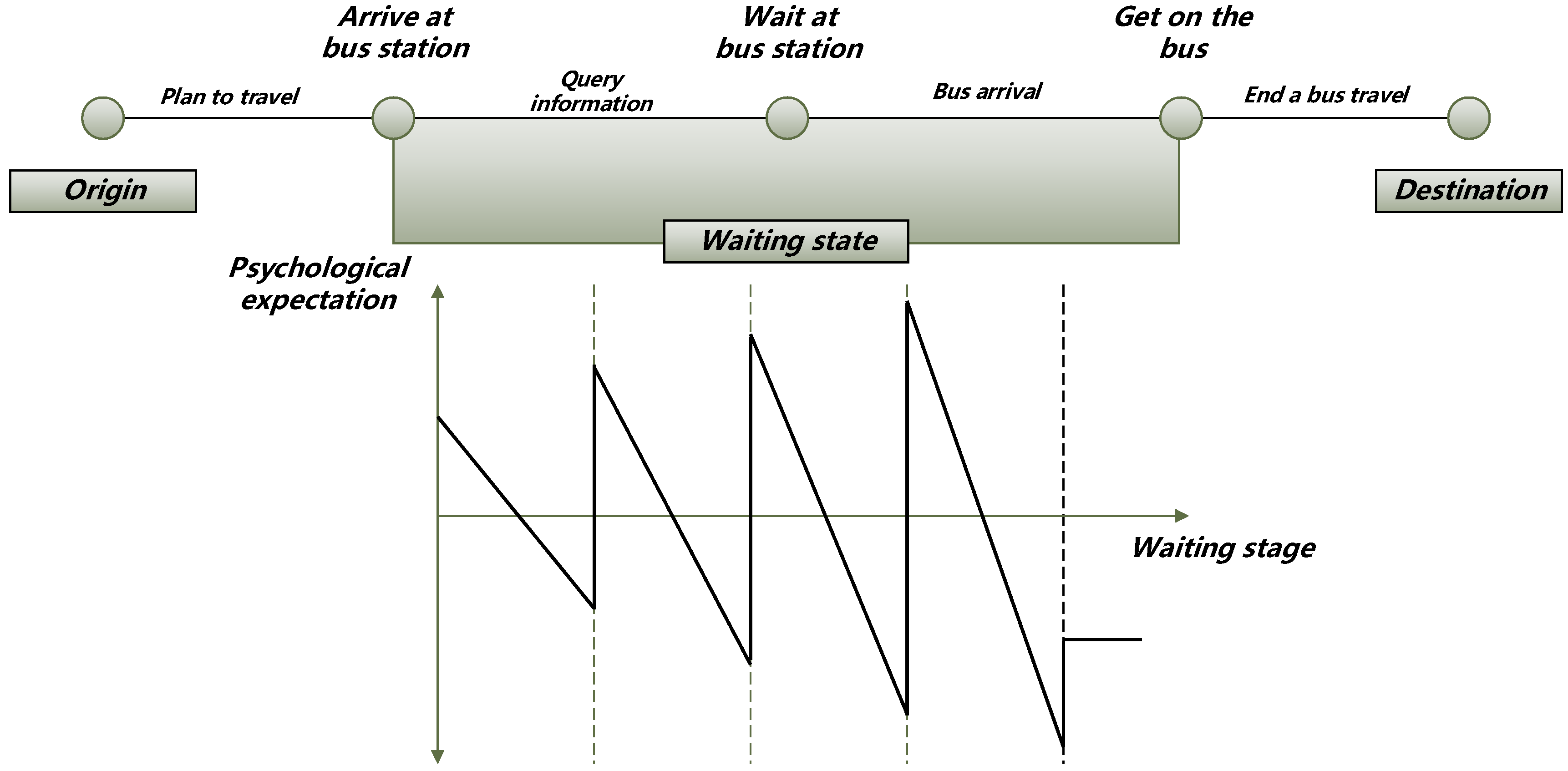

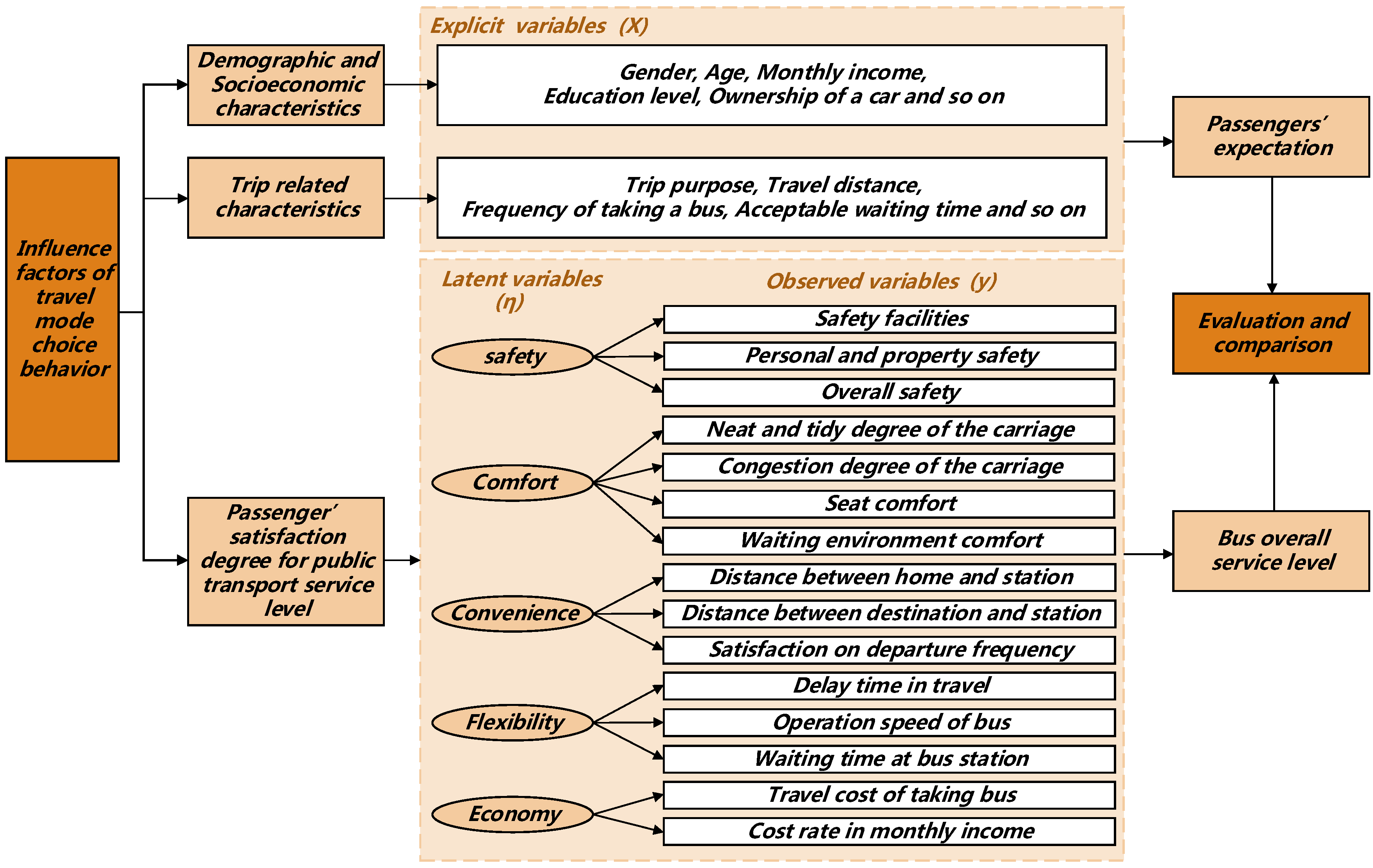
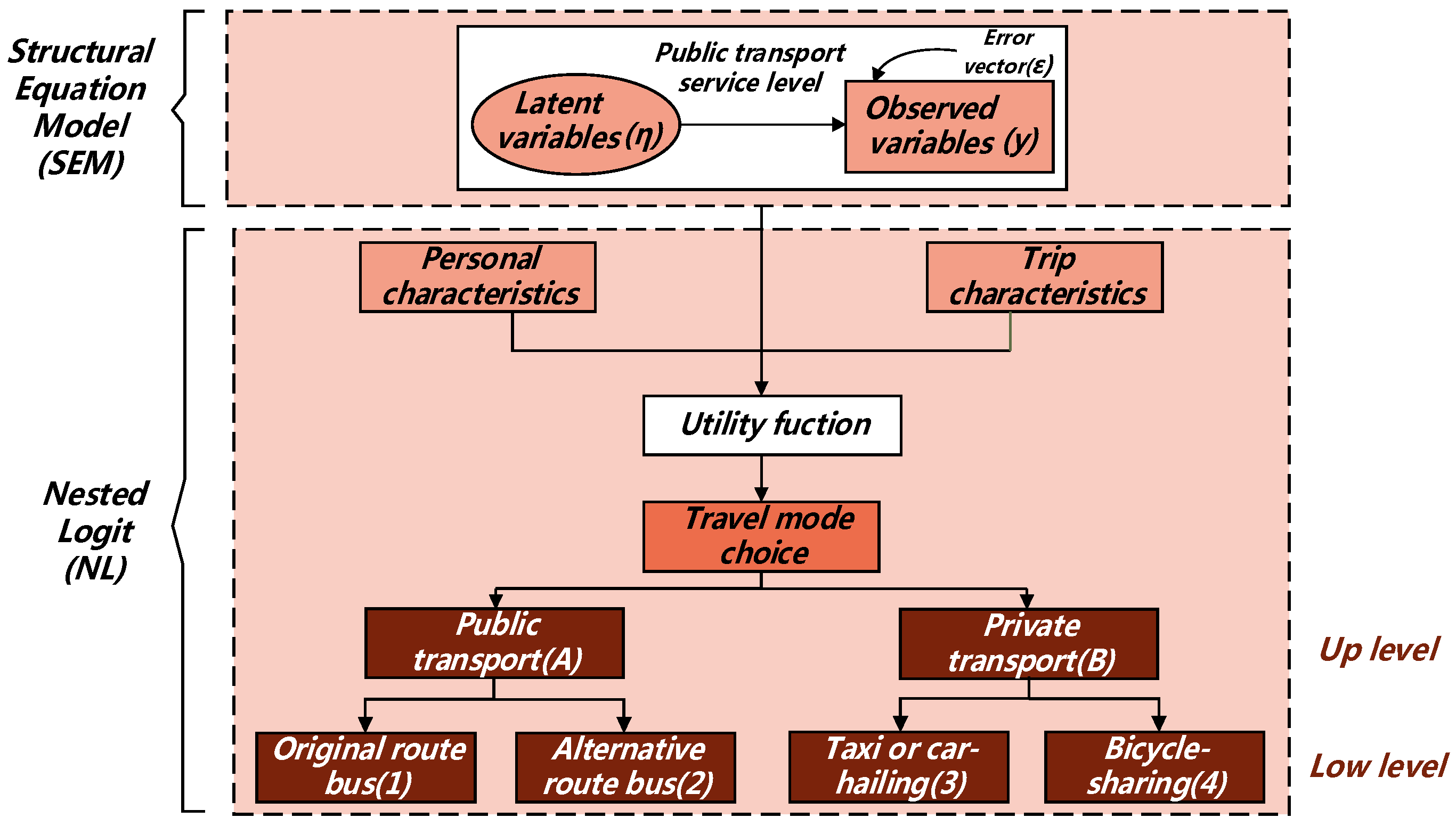





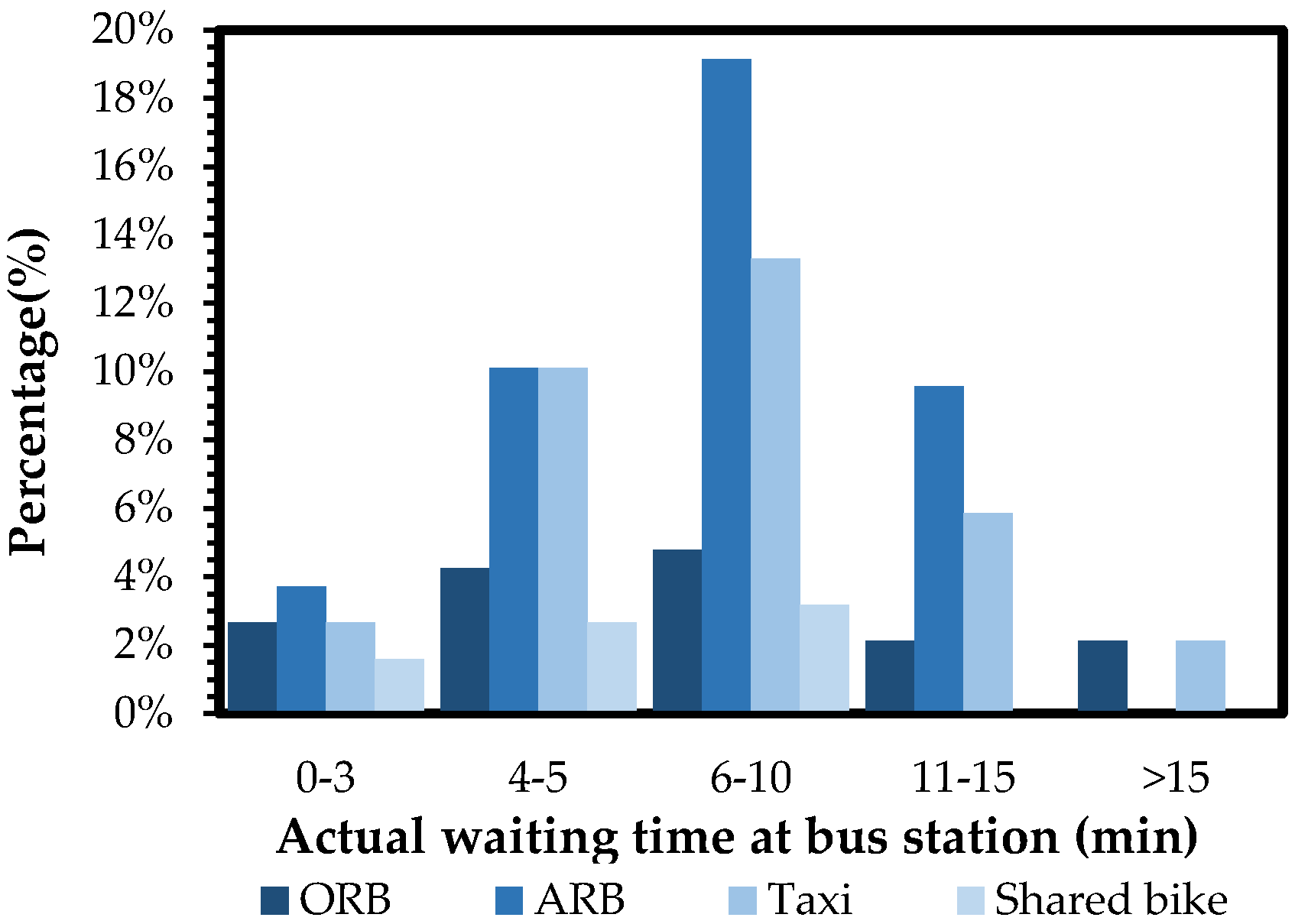
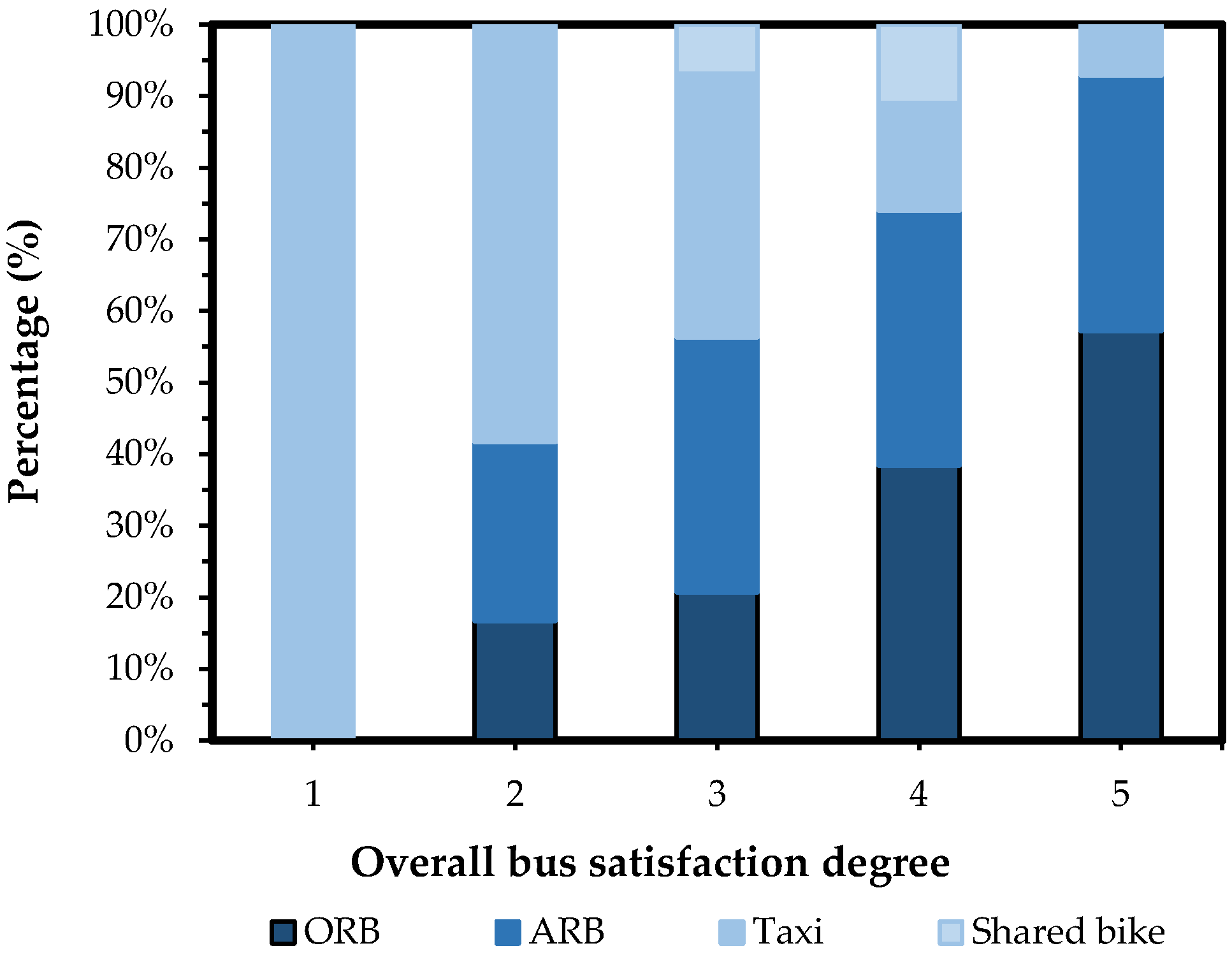
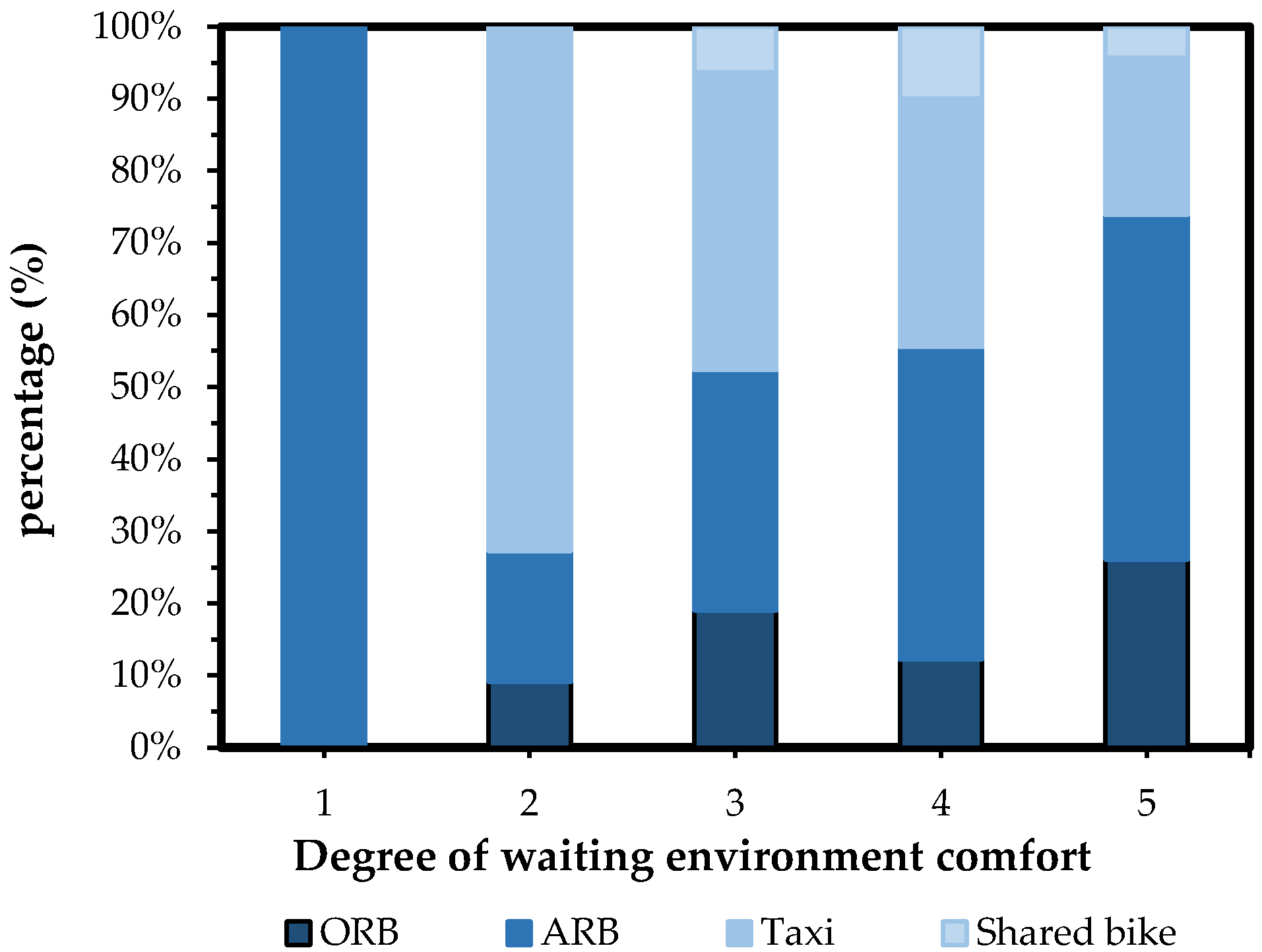
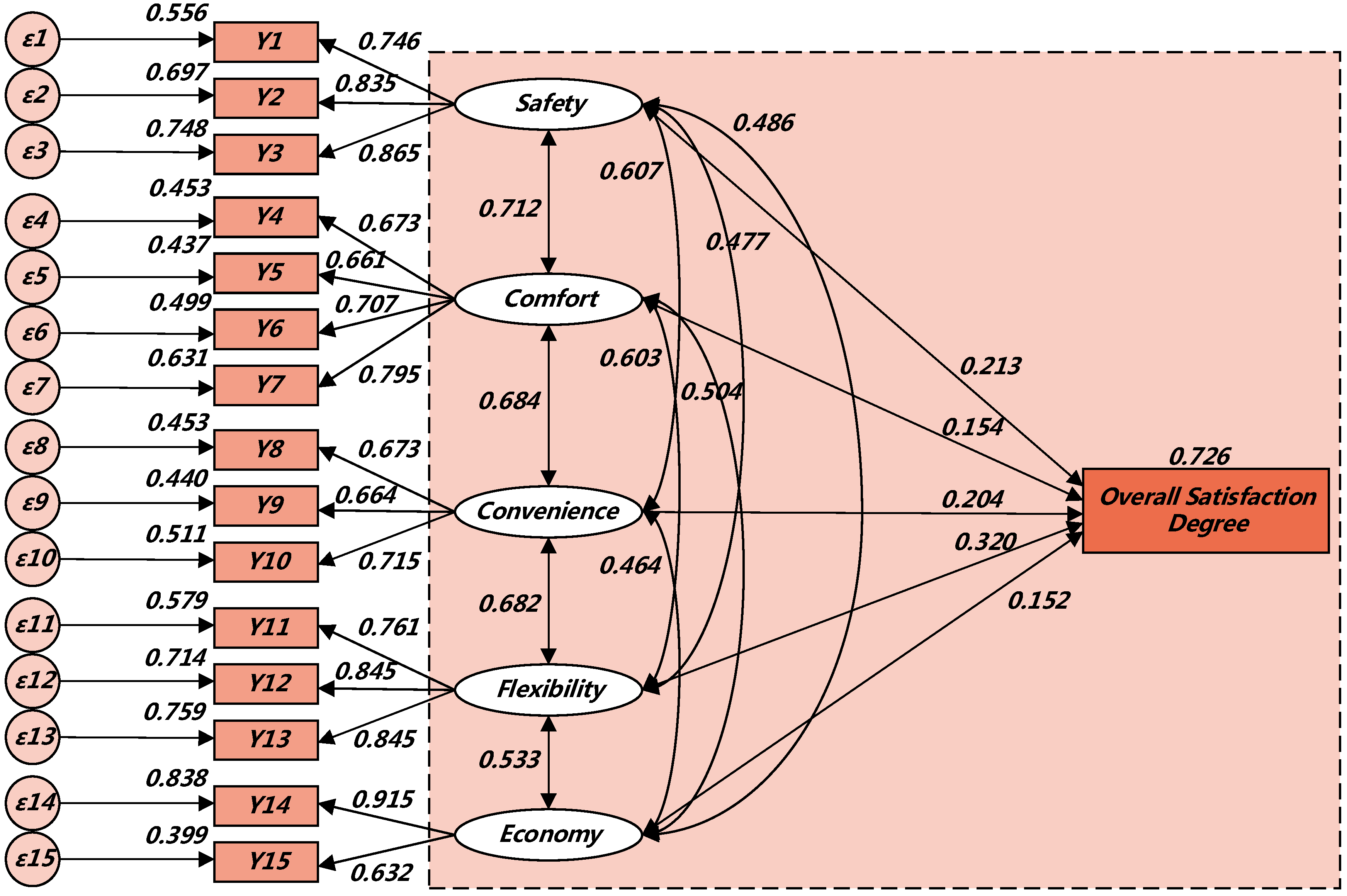
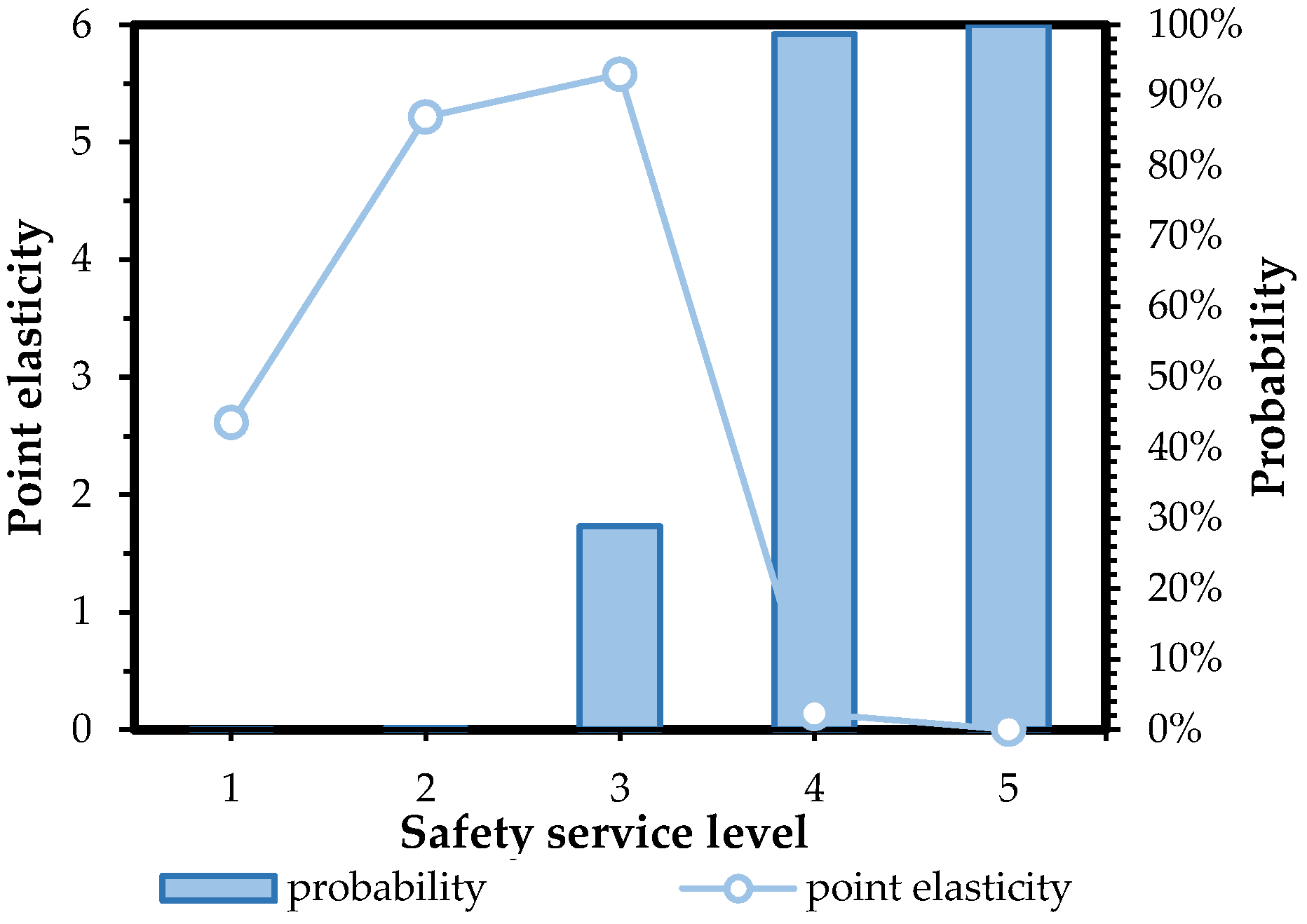
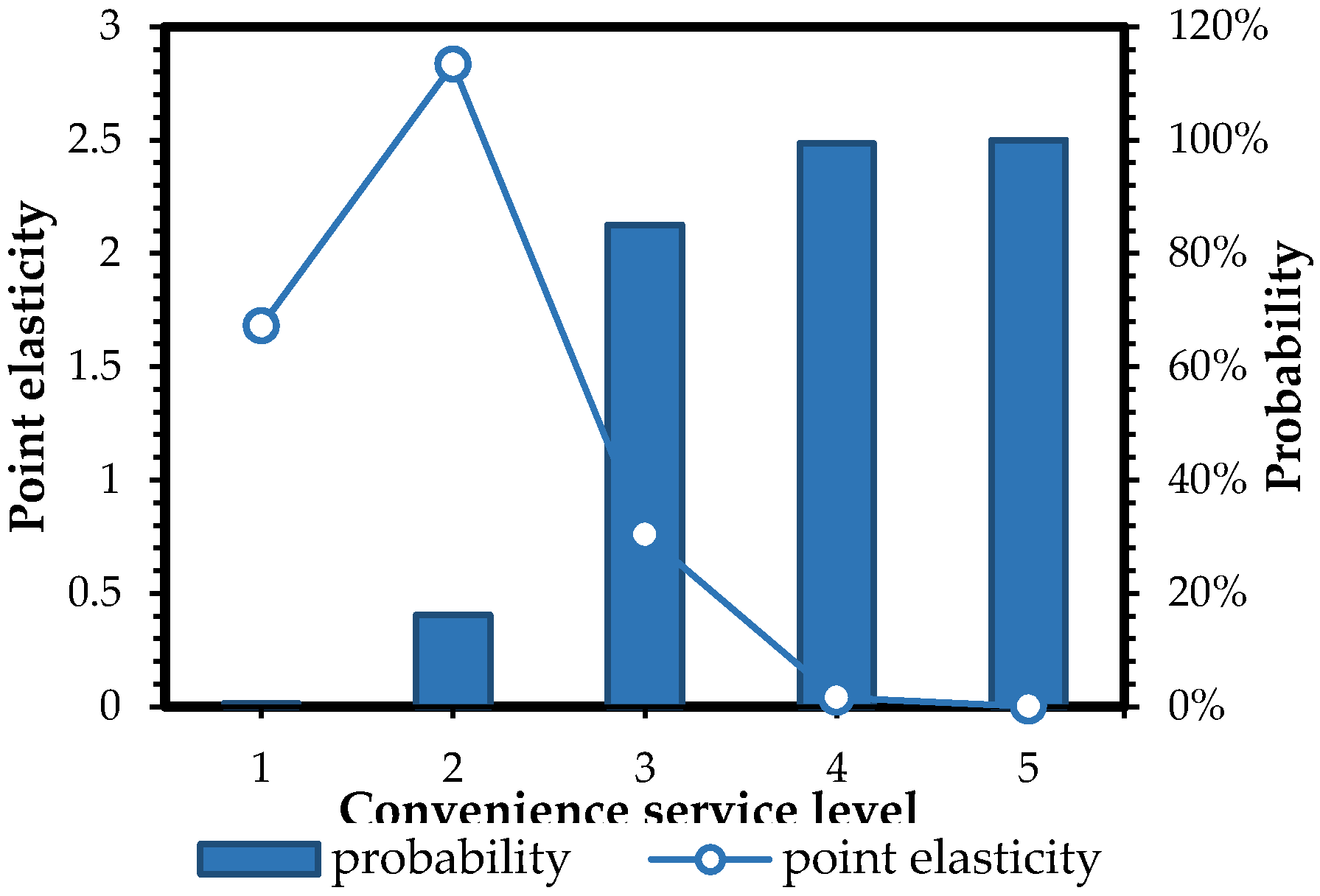
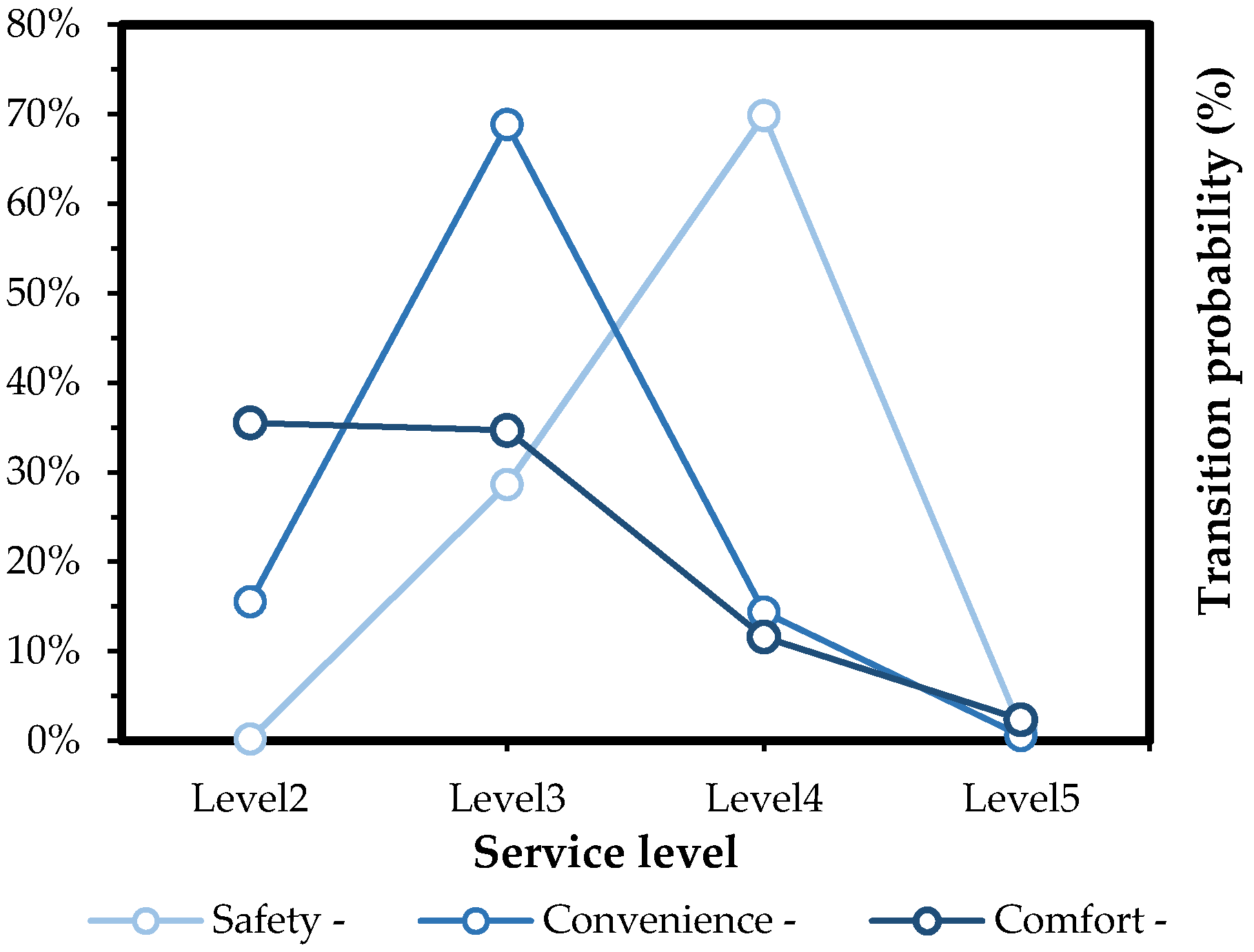
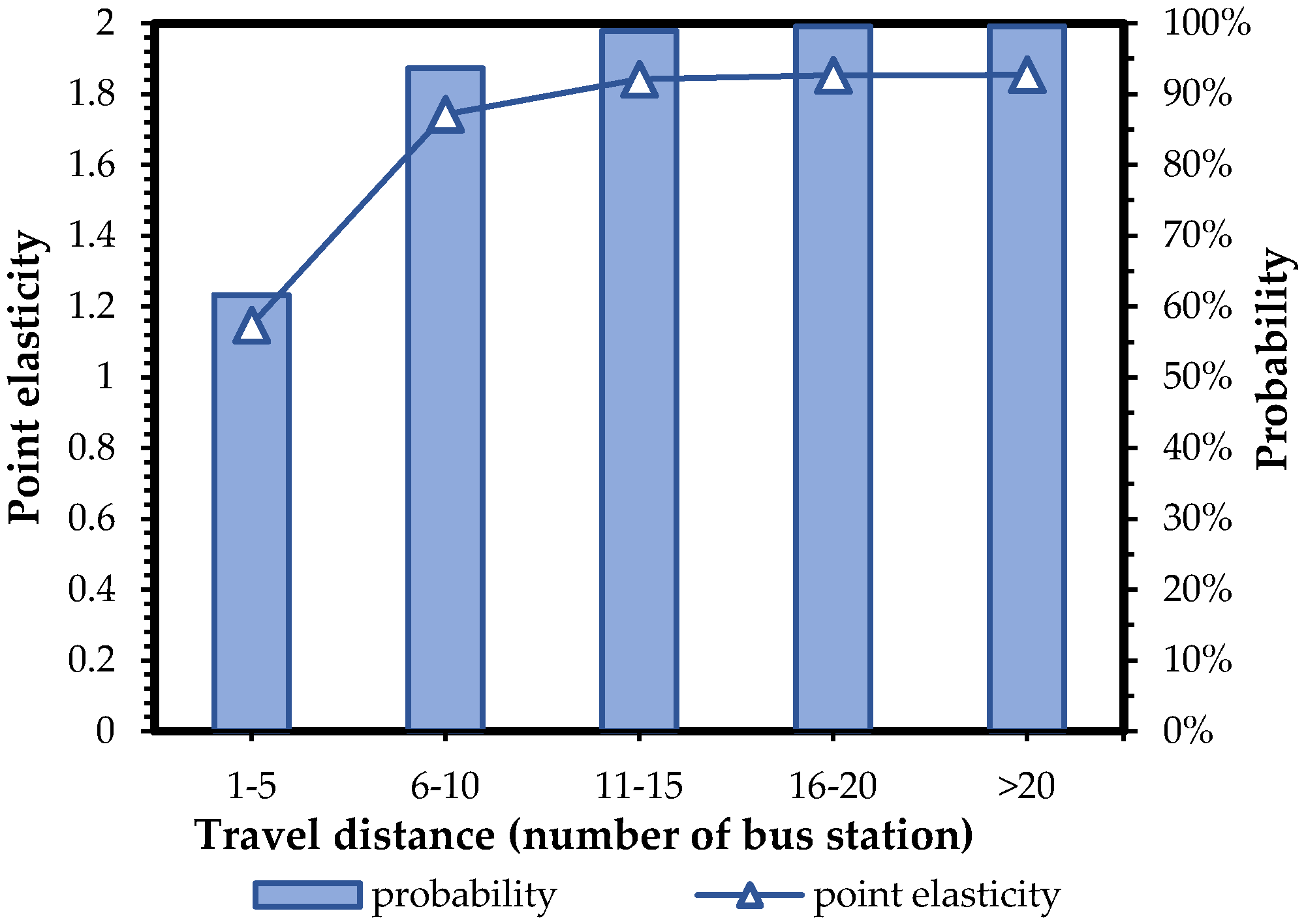
| Variable Description | Illustration | Percentage (%) | |
|---|---|---|---|
| Demographic and Socioeconomic | |||
| Variable for gender | Gender 1 | Male | 51.06 |
| Gender 2 | Female | 48.94 | |
| Variable for age | 34.49 (Average Age) | ||
| Variable for monthly income(yuan) | Income 1 | <3000 | 26.06 |
| Income 2 | 3000–5000 | 36.70 | |
| Income 3 | 500–10,000 | 24.47 | |
| Income 4 | >10,000 | 12.77 | |
| Variable for Education level | Level 1 | High school or below | 23.93 |
| Level 2 | Junior college | 33.51 | |
| Level 3 | Bachelor degree | 37.77 | |
| Level 4 | Master and doctor degree | 4.79 | |
| Variable for a private car | Car 1 | With a private car | 54.25 |
| Car 2 | Without a private car | 45.75 | |
| Trip related characteristics | |||
| Variable for trip purpose | Purpose 1 | Commute or family obligations 1 | 51.06 |
| Purpose 2 | Shopping and leisure, visiting relatives, and tourism | 48.94 | |
| Variable for commute distance (the number of bus station) | Distance 1 | 1–5 | 5.32 |
| Distance 2 | 6–10 | 30.32 | |
| Distance 3 | 11–15 | 40.96 | |
| Distance 4 | 16–20 | 17.55 | |
| Distance 5 | >20 | 5.85 | |
| Variable for frequency of taking buses | Frequency 1 | Rarely | 12.23 |
| Frequency 2 | Monthly | 18.08 | |
| Frequency 3 | Weekly | 23.40 | |
| Frequency 4 | Once 2–3 days | 18.62 | |
| Frequency 5 | daily | 27.67 | |
| Variable for acceptable waiting time (min) | Time 1 | 0–5 | 16.48 |
| Time 2 | 6–10 | 32.44 | |
| Time 3 | 11–15 | 37.23 | |
| Time 4 | 16–20 | 9.57 | |
| Time 5 | 21–30 | 2.66 | |
| Time 6 | >30 | 1.62 | |
| Latent Variables | Observed Variables | Number of Observed Variables | α Coefficient | Average Score |
|---|---|---|---|---|
| : Safety | Y1: Safety facilities | 3 | 0.852 | 4.088 |
| Y2: Personal and property safety | 3.758 | |||
| Y3: Overall safety | 3.948 | |||
| : Comfort | Y4: Neat and tidy degree of the carriage | 4 | 0.785 | 4.026 |
| Y5: Congestion degree of the carriage | 3.407 | |||
| Y6: Seat comfort | 3.897 | |||
| Y7: Waiting environment comfort at bus station | 3.644 | |||
| : Convenience | Y8: Distance between home and bus station | 3 | 0.729 | 3.613 |
| Y9: Distance between destination and bus station | 3.629 | |||
| Y10: Satisfaction on departure frequency | 3.490 | |||
| : Flexibility | Y11: Waiting time at bus station | 3 | 0.860 | 3.196 |
| Y12: Delay time in travel | 3.340 | |||
| Y13: Operation speed of bus | 3.464 | |||
| : Economy | Y14: Travel cost of taking a bus | 2 | 0.733 | 3.665 |
| Y15: Cost rate in monthly income | 3.526 | |||
| Overall satisfaction degree | 3.433 | |||
| Path | Estimate | Standard Error (S.E.) | Critical Ratio (C.R.) | p-Value | ||
|---|---|---|---|---|---|---|
| Y2 | << | 1.000 | - | - | - | |
| Y1 | << | 0.746 | 0.081 | 10.948 | *** | |
| Y3 | << | 0.865 | 0.077 | 13.659 | *** | |
| Y5 | << | 1.000 | - | - | - | |
| Y4 | << | 0.673 | 0.109 | 7.651 | *** | |
| Y6 | << | 0.707 | 0.113 | 7.937 | *** | |
| Y7 | << | 0.795 | 0.097 | 9.158 | *** | |
| Y9 | << | 1.000 | - | - | - | |
| Y8 | << | 0.673 | 0.140 | 7.803 | *** | |
| Y10 | << | 0.715 | 0.155 | 7.183 | *** | |
| Y12 | << | 1.000 | - | - | - | |
| Y11 | << | 0.761 | 0.087 | 11.830 | *** | |
| Y13 | << | 0.871 | 0.075 | 14.197 | *** | |
| Y15 | << | 1.000 | - | - | - | |
| Y14 | << | 0.915 | 0.221 | 6.392 | * | |
| Overall Satisfaction Degree | << | 0.213 | 0.074 | 2.734 | 006 ** | |
| Overall Satisfaction Degree | << | 0.154 | 0.095 | 1.668 | 095 * | |
| Overall Satisfaction Degree | << | 0.204 | 0.117 | 2.123 | 0.034 ** | |
| erall Satisfaction Degree | << | 0.320 | 0.077 | 4.069 | *** | |
| Overall Satisfaction Degree | << | 0.152 | 0.078 | 2.498 | 0.013 ** | |
| Fix Index | SEM Models | Criteria of Acceptable Fit |
|---|---|---|
| (Chi-Square) | 141.989 | Smaller values |
| CMIN/DF (Likelihood-Ratio Chi-Square/degrees of freedom) | 1.578 | <3 |
| GFI (goodness-of-fit index) | 0.915 | >0.9 |
| AGFI (adjusted goodness-of-fit index) | 0.872 | >0.9 |
| RMSEA (root mean square error of approximation) | 0.055 | <0.05(good fit) <0.08(reasonable fit) |
| RMR (root mean square residual) | 0.035 | <0.05 |
| NFI (normed fit index) | 0.914 | >0.9 |
| IFI (incremental fit index) | 0.967 | >0.9 |
| TLI (Tacker–Lewis index) | 0.955 | >0.9 |
| CFI (comparative fit index) | 0.966 | >0.9 |
| Model | Variable | Value | S.E | t-Test |
|---|---|---|---|---|
| Up level model | ASC1 | −14.695915 | 4.689069 | −3.134080 |
| Gender | 1.126083 | 0.904913 | 1.244410 | |
| Monthly income | −2.340057 | 0.702414 | −3.331449 | |
| Education level | −1.089239 | 0.470627 | −2.314443 | |
| Trip purpose | −1.514132 | 0.735206 | −2.059466 | |
| Travel distance | −1.609863 | 0.812251 | −1.981978 | |
| Acceptable waiting time | 1.124283 | 0.538017 | 2.089681 | |
| Safety | 2.613647 | 0.888649 | 2.941145 | |
| Comfort | 0.871234 | 0.585514 | 1.487981 | |
| Convenience | 1.690252 | 0.590711 | 2.861384 | |
| Logsum | 0.823712 | 0.297657 | 2.767317 | |
| LL(0): −130.311670 LL(): −26.104927 −2LL(0)–2LL(): 208.413486 : 0.799673 : 0.715260 | ||||
| Variable | Value | S.E | t-Test | |
| Low level model | ASC1 | 0.280311 | 0.499432 | 0.561259 |
| ASC2 | 0.883488 | 0.394253 | 2.240918 | |
| ASC4 | 6.535504 | 2.275361 | 2.872293 | |
| Monthly income | 0.290596 | 0.158166 | 1.837283 | |
| Education level | −0.490799 | 0.222063 | −2.210175 | |
| Private car | 4.233176 | 1.194679 | 3.543358 | |
| Trip purpose | 2.820997 | 0.837977 | 3.366437 | |
| Travel distance | 2.260247 | 0.587686 | 3.846011 | |
| Bus ride frequency | 1.176485 | 0.395064 | 2.977963 | |
| Acceptable waiting time | 0.853989 | 0.517879 | 1.649015 | |
| LL(0): −260.623340 LL(): −200.429774 −2LL(0)–2LL(): 120.387133 : 0.230960 : 0.192590 | ||||
© 2018 by the authors. Licensee MDPI, Basel, Switzerland. This article is an open access article distributed under the terms and conditions of the Creative Commons Attribution (CC BY) license (http://creativecommons.org/licenses/by/4.0/).
Share and Cite
Han, Y.; Li, W.; Wei, S.; Zhang, T. Research on Passenger’s Travel Mode Choice Behavior Waiting at Bus Station Based on SEM-Logit Integration Model. Sustainability 2018, 10, 1996. https://doi.org/10.3390/su10061996
Han Y, Li W, Wei S, Zhang T. Research on Passenger’s Travel Mode Choice Behavior Waiting at Bus Station Based on SEM-Logit Integration Model. Sustainability. 2018; 10(6):1996. https://doi.org/10.3390/su10061996
Chicago/Turabian StyleHan, Yan, Wanying Li, Shanshan Wei, and Tiantian Zhang. 2018. "Research on Passenger’s Travel Mode Choice Behavior Waiting at Bus Station Based on SEM-Logit Integration Model" Sustainability 10, no. 6: 1996. https://doi.org/10.3390/su10061996




